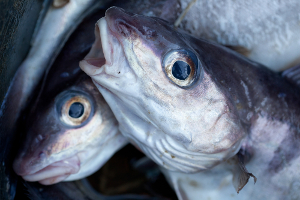Seabed conditions key to survival of juvenile cod, haddock and whiting
Published: 24 March 2017
Links between seabed type and quality are closely related to the abundance and size of young commercially fished species such as cod, haddock and whiting.
Links between seabed type and quality are closely related to the abundance and size of young commercially fished species such as cod, haddock and whiting.
A new study, led by the University of Glasgow and published today in Marine Ecology Progress Series, examines the abundance and size of these three types of commercial fish over the course of two years in the South Arran Nature Conservation Marine Protected Area in the Firth of Clyde.
The Firth of Clyde was once an important area for a variety of fish such as haddock and cod and whiting. However, the populations of these fish have changed to the extent that they no longer support the fisheries they once did.
Previous studies have shown that there is a now a lower diversity of species, and the current fish population in the Clyde (while remaining high in biomass) is dominated by small whiting below the minimum landing size.
In this study researchers analysed factors which could be affecting the species from recovering. They found that the biodiversity of the seabed affects the abundance and growth of juvenile demersal fish.
The early stages of a fish’s life may depend on “nursery” areas where they can feed and shelter from predators. But until now we knew little about what makes a good nursery area for the most important commercial fish.
Cod were found to be most abundant in shallow, sheltered areas where the seabed was composed of gravels and pebbles that contained maerl – a protected red algae which supports a particularly high diversity of species.
The study also reports that in 2014 while fewer cod were observed than in 2013, cod numbers remained fairly constant within gravel/pebble seabed types, whereas they reduced in other seabed types (such as sediment types with boulders and sand). Researchers believe that this hints at gravel/pebble seabed being important for the young of this species. However this type of seabed could be more vulnerable to disturbance, such as by fishing by dredges which can take place in these shallower areas.
In contrast more haddock and whiting were observed over sheltered seabed made up of sand or mud. Interestingly, despite previous research which suggested that whiting did not have a preference for any particular nursery habitat, this study did find that sandy seabeds were favoured by them.
Sophie Elliott, from the University of Glasgow, said: “These results demonstrate that measures to protect juvenile fish should be tailored to the species and life stages, and that there may not be general rules which apply evenly within groups of closely-related fish.
“The sustainability of the fishing industry depends on the supply of new fish into fishing grounds to replace those caught. In turn these fish depend on their environment for food and shelter. If we can identify which aspects of the environment are most important to fish these can be prioritised for protection for the benefit of fisheries and to aid the recovery of stocks.”
David Donnan, Scottish Natural Heritage, said: “Current fishery management measures tend to focus on controlling the amount of fish caught, by net mesh sizes and so on. While these measures remain important there is increasing recognition that protecting habitats that are crucial to the life history of the target fish should be an important part of the overall management package.”
The study also found that fish changed their environment with increasing size, with cod moving to relatively more rugose seabed types as they increase in size within their first year of life. Biodiversity also affected cod growth rates. Haddock and whiting were observed to move to deeper waters as they grow. .
Dr David Bailey, from the Institute of Biodiversity, Animal Health and Comparative Medicine, said: “We’ve shown that both the type and quality of the seabed have powerful effects on the numbers of juvenile fish they support. This is important information and should lead to measures to allow nursery areas to recover from past impacts so they can aid the recovery of fish stocks and the sustainability of fishing.”
The study took place between 2013 and 2014 and used stereo baited remote underwater video surveys. Three baited camera systems were used, each consisting of a pair of high definition video cameras in waterproof housings.
The study, ‘Juvenile gadoid habitat and ontogenetic shift observations using stereo-video baited cameras’ is published in Marine Ecological Progress Series. The work was funded by Marine Scotland (Clyde 2020), Scottish Natural Heritage, ClimateXChange and NERC NFSD.
Media Enquiries: ali.howard@glasgow.ac.uk or elizabeth.mcmeekin@glasgow.ac.uk / 0141 330 6557 or 0141 330 4831
First published: 24 March 2017
<< March

